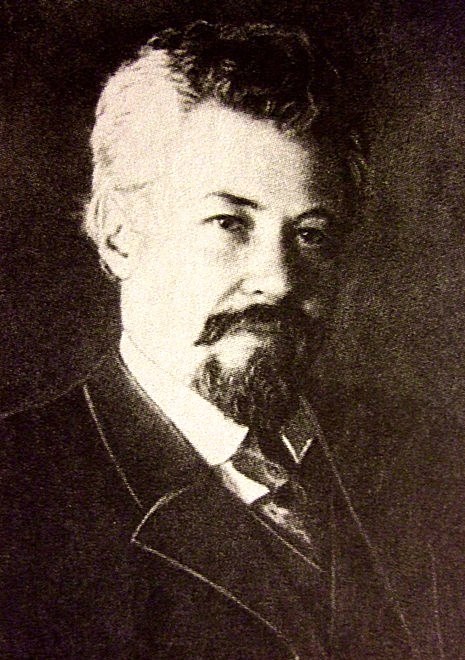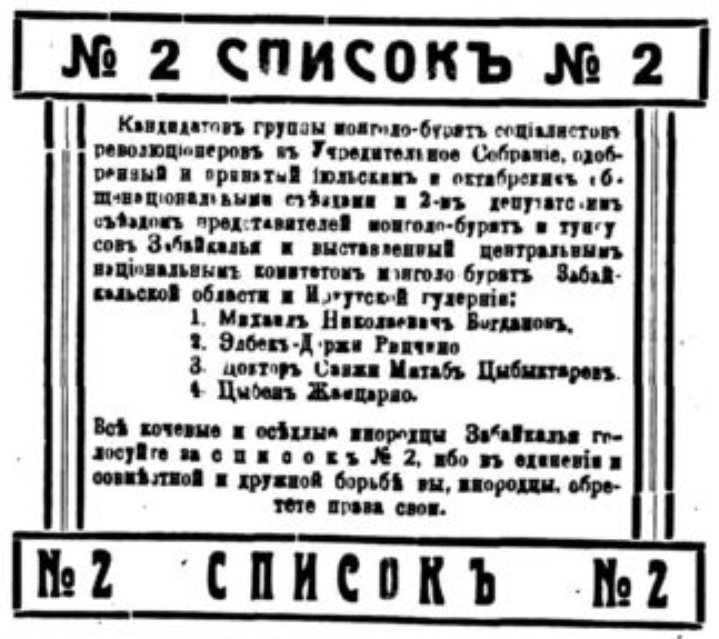|
Burnatskom
The Central National Committee of the Buryat-Mongols of Eastern Siberia (russian: ą”ąĄąĮčéčĆą░ą╗čīąĮčŗą╣ ąĮą░čåąĖąŠąĮą░ą╗čīąĮčŗą╣ ą║ąŠą╝ąĖč鹥čé ą▒čāčĆčÅčé-ą╝ąŠąĮą│ąŠą╗ąŠą▓ ąÆąŠčüč鹊čćąĮąŠą╣ ąĪąĖą▒ąĖčĆąĖ), generally known by its Russian language abbreviation ''Burnatskom'' (ąæčāčĆąĮą░čåą║ąŠą╝), was an organization of Buryat people in Russia during the Russian Revolution. Immediately following the February Revolution, Gombojab Tsybikov (chair of Mongol Philology at the Oriental Institute of Vladivostok) travelled to Buryatia and together with , Tsyben Zhamtsarano, , Elbegdorj Rinchino, and others founded the nucleus of Burnatskom in March 1917. The group gathered virtually all Buryat prominent leaders at the time. Burnatskom supported Alexander Kerensky's Provisional Government and promoted national autonomy. On 25 April 1917 the First All-Buryat Congress formalized the foundation of Burnatskom.''Buryad Unen''100 ą╗ąĄčé ąĮą░ąĘą░ą┤ ą┐ąŠčÅą▓ąĖą╗čüčÅ ąæčāčĆąĮą░čåą║ąŠą╝ - ą┐ąĄčĆą ... [...More Info...] [...Related Items...] OR: [Wikipedia] [Google] [Baidu] |
State Of Buryat-Mongolia
The State of Buryat-Mongolia ( Buryat: ''ąæčāčĆčÅą░ą┤-ą£ąŠąĮą│ąŠą╗ čāą╗ą░čü'' ''ßĀ¬ßĀżßĀĘßĀóßĀĀßĀ│ ßĀ«ßĀŻßĀ®ßĀŁßĀŻßĀ» ßĀ¬ßĀżßĀ»ßĀżßĀ░'') was a buffer Buryat-Mongolian state,''ąæą░ą▒ą░ą║ąŠą▓ ąÆ. ąÆ.'', ąæčāčĆąĮą░čåą║ąŠą╝ - ąæčāčĆąĮą░čĆą┤čāą╝ą░: ą┐ąĄčĆą▓čŗą╣ ąŠą┐čŗčé ąĮą░čåąĖąŠąĮą░ą╗čīąĮąŠ-ą│ąŠčüčāą┤ą░čĆčüčéą▓ąĄąĮąĮąŠą│ąŠ čüčéčĆąŠąĖč鹥ą╗čīčüčéą▓ą░ ą▓ ąæčāčĆčÅčéąĖąĖ, ąŻą╗ą░ąĮ-ąŻą┤čŹ, 1997 ą│. during the Russian Civil War. It was established according to by the first All-Buryat congress on 25 April 1917. The main government body was Burnatskom, the Buryat National Committee. After the collapse of the Soviet regime under the advance of the Whites and the Czechoslovakian division, the State of Buryat-Mongolia was recognized by the Soviets in 1918, and later by Grigory Semyonov's Government of Transbaikalia. The state de facto ceased to exist after the formation of the Far Eastern Republic, which divided Buryat-Mongolia in two: 4 ''aimags'' became part of the Far Eastern Republic, ... [...More Info...] [...Related Items...] OR: [Wikipedia] [Google] [Baidu] |
Rinchingiin Elbegdorj
Rinchingiin Elbegdorj ( mn, ąĀąĖąĮčćąĖąĮą│ąĖą╣ąĮ ąŁą╗ą▒菹│ą┤ąŠčĆąČ; russian: ąŁą╗ą▒ąĄ╠üą║-ąöąŠčƹȹĖ╠ü ąĀąĖąĮčćąĖąĮąŠ, ''─¢lbek-Dorzhi Rinchino''; May 16, 1888 ŌĆōJune 10, 1938) was a Buryat nationalist revolutionary who played leading roles in the Outer Mongolian Revolution of 1921 and the early political development of the Mongolian People's Republic.Alan J. K. Sanders Historical dictionary of Mongolia. Rowman & Littlefield, 2003, He was an important member of the Mongolian People's Revolutionary Party representing the Buryats and served as Chairman of the Revolutionary War Council of the Mongolian People's Army. Early life and career Elbegdorj was born on May 16, 1888 into a herding family in Barguzinsky District, Transbaikal. He became a communist around 1910 while studying law at Saint Petersburg State University. He then moved to Troitskosavsk where he wrote for a local newspaper and traveled throughout Mongolia, becoming involved in clandestine Mongolian revolutionar ... [...More Info...] [...Related Items...] OR: [Wikipedia] [Google] [Baidu] |
Buryad Unen
''Buryad Unen'' ( bxr, ąæčāčĆčÅą░ą┤ 껹Į菹Į, , "The Buryat Truth") is the main newspaper in the Buryat language, founded in December 1921 and originally published in the top-down Mongolian script before switching to Latin script in 1931-1938 and eventually Cyrillic script from 1939. It was founded as (ąæčāčĆčÅą░ą┤-ą£ąŠąĮą│ąŠą╗ąĖąĖąĮ 껹Į菹Į, , ''Buryat-Mongol Truth'') in 1921 in Chita, Buryat-Mongol ASSR, within Russian SFSR. Now it published in Ulan-Ude, as Chita was carved out of the Buryat-Mongol ASSR. In 1958, Buryat-Mongol ASSR removed the "-Mongol" from its official name, and the name of this newspaper followed the change. In the 1970s, it was published six times a week, with a circulation of approximately 8500. History of the newspaper .The paper was originally published in Chita. In 1923, the publication of the paper moved to Ulan-Ude. It was printed in the vertical Mongolian script, which, due to its universality, leveled the dialect differences of the Buryats an ... [...More Info...] [...Related Items...] OR: [Wikipedia] [Google] [Baidu] |
Republic Of Bashkortostan
The Republic of Bashkortostan or Bashkortostan ( ba, ąæą░čłęĪąŠčĆč鹊čüčéą░ąĮ ąĀąĄčüą┐čāą▒ą╗ąĖą║ą░ę╗čŗ, Bashqortostan Respublikahy; russian: ąĀąĄčüą┐čāą▒ą╗ąĖą║ą░ ąæą░čłą║ąŠčĆč鹊čüčéą░ąĮ, Respublika Bashkortostan),; russian: ąĀąĄčüą┐čā╠üą▒ą╗ąĖą║ą░ ąæą░čłą║ąŠčĆč鹊čüčéą░╠üąĮ, r=Respublika Bashkortostan, p=r╩▓╔¬s╦łpubl╩▓╔¬k╔Ö b╔Ö╩ék╔Ört╔É╦łstan also Archaism, unofficially called Badzhgard, Bashkiria (russian: ąæą░čłą║ąĖčĆąĖčÅ, tr. Bashkiriya), is a Republics of Russia, republic of Russia located between the Volga and the Ural Mountains in Eastern Europe. It covers and has a population of 4 million. It is Russia's 7th List of federal subjects of Russia by population, most populous federal subject and most populous republic. Its capital city, capital and largest city is Ufa. Bashkortostan was established on .ąØą░čåąĖąŠąĮą░ą╗čīąĮąŠ-ą│ąŠčüčāą┤ą░čĆčüčéą▓ąĄąĮąĮąŠąĄ čāčüčéčĆąŠą╣čüčéą▓ąŠ ąæą░čłą║ąŠčĆč鹊čüčéą░ąĮą░, 1917ŌĆō1925 ą│ą│: ą×ą▒čēąĄąĄ ą▓ą▓ąĄą┤ąĄąĮąĖąĄ ąĖ ąóąŠą╝ 1 // ąæąĖą╗ą░ą╗ ą ... [...More Info...] [...Related Items...] OR: [Wikipedia] [Google] [Baidu] |
Grigory Mikhaylovich Semyonov
Grigory Mikhaylovich Semyonov, or Semenov (russian: ąōčĆąĖą│ąŠ╠üčĆąĖą╣ ą£ąĖčģą░╠üą╣ą╗ąŠą▓ąĖčć ąĪąĄą╝čæąĮąŠą▓; September 25, 1890 ŌĆō August 30, 1946), was a Japanese-supported leader of the White movement in Transbaikal and beyond from December 1917 to November 1920, a lieutenant general, and the ''ataman'' of Baikal Cossacks (1919). Semyonov was also a prominent figure in the White Terror. Early life and career Semyonov, born in the Transbaikal region of eastern Siberia. His father, Mikhail Petrovich Semyonov, was Russian; his mother was a Buryat. Semyonov spoke Mongolian and Buryat fluently. He joined the Imperial Russian Army in 1908 and graduated from Orenburg Military School in 1911. Commissioned first as a khorunzhiy (cornet or lieutenant), he rose to the rank of ''yesaul'' (Cossack captain), distinguished himself in battle against the Germans and the Austro-Hungarians in World War I, and earned the Saint George's Cross for courage.Bisher, ''White Terror''. Pyotr Wran ... [...More Info...] [...Related Items...] OR: [Wikipedia] [Google] [Baidu] |
White Army
The White Army (russian: ąæąĄą╗ą░čÅ ą░čĆą╝ąĖčÅ, Belaya armiya) or White Guard (russian: ąæ诹╗ą░čÅ ą│ą▓ą░čĆą┤č¢čÅ/ąæąĄą╗ą░čÅ ą│ą▓ą░čĆą┤ąĖčÅ, Belaya gvardiya, label=none), also referred to as the Whites or White Guardsmen (russian: ąæ诹╗ąŠą│ą▓ą░čĆą┤ąĄą╣čåčŗ/ąæąĄą╗ąŠą│ą▓ą░čĆą┤ąĄą╣čåčŗ, Belogvardeytsi, label=none), was a common collective name for the armed formations of the White movement and anti-Soviet governments during the Russian Civil War. They fought against the Red Army of the Bolsheviks. When it was created, the structure of the Russian Army of the Provisional Government period was used, while almost every individual formation had its own characteristics. The military art of the White Army was based on the experience of the First World War, which, however, left a strong imprint on the specifics of the Civil War. History The name "White" is associated with white symbols of the supporters of the pre-revolutionary order, dating back to the time of the French Revolution, ... [...More Info...] [...Related Items...] OR: [Wikipedia] [Google] [Baidu] |
Tomsk
Tomsk ( rus, ąóąŠą╝čüą║, p=tomsk, sty, ąóę»ęŻ-č鹊čĆą░) is a city and the administrative center of Tomsk Oblast in Russia, located on the Tom River. Population: Founded in 1604, Tomsk is one of the oldest cities in Siberia. The city is a notable educational and scientific center with six state universities consisting of over 100,000 students, including Tomsk State University, the oldest university in Siberia. History Tomsk originated with a decree by Tsar Boris Godunov in 1604 after , the Tatar duke of , asked for the Tsar's protection against Kirghiz bandits. The Tsar sent 200 Cossacks under the command of and Gavriil Ivanovich Pisemsky to construct a fortress on the bank of the Tom River, overlooking what would become the city of Tomsk. Toian ceded the land for the fortress to the Tsar. [...More Info...] [...Related Items...] OR: [Wikipedia] [Google] [Baidu] |
Provisional Siberian Government (Vladivostok)
The Provisional Siberian Government (later the Provisional Government of Autonomous Siberia), was an ephemeral government for Siberia created by the White movement. History Background The seizure of power by the Bolshevik Party in Petrograd in the Russian Revolution of November 1917 was followed by the dispersal of the Russian Constituent Assembly early in the morning of January 19, 1918 (N.S.), a body which had been dominated by the elected representatives of the Party of Socialists-Revolutionaries (PSR), headed by Victor Chernov. This usurpation of authority by the Council of People's Commissars and the 2nd All-Russian Congress of Soviets did not spell the end of opposition to the Bolshevik regime, however. In December 1917 elections were held to select a Siberian Regional Duma which was to be convened in the city of Tomsk. Owing to the revolutionary temper of the times, the middle class and the bourgeoisie had been excluded from the elections to this body, a decision whic ... [...More Info...] [...Related Items...] OR: [Wikipedia] [Google] [Baidu] |
1917 Russian Constituent Assembly Election
Elections to the Russian Constituent Assembly were held on 25 November 1917, although some districts had polling on alternate days, around two months after they were originally meant to occur, having been organized as a result of events in the February Revolution. They are generally recognised to be the first free elections in Russian history. Various academic studies have given alternative results. However, all clearly indicate that the Bolsheviks were clear winners in the urban centres, and also took around two-thirds of the votes of soldiers on the Western Front. Nevertheless, the Socialist-Revolutionary party topped the polls, winning a plurality of seats (no party won a majority) on the strength of support from the country's rural peasantry, who were for the most part one-issue voters, that issue being land reform. The elections, however, did not produce a democratically-elected government. The Constituent Assembly only met for a single day the following January before being ... [...More Info...] [...Related Items...] OR: [Wikipedia] [Google] [Baidu] |
Transbaikal Electoral District (Russian Constituent Assembly Election, 1917)
The Transbaikal electoral district (russian: ąŚą░ą▒ą░ą╣ą║ą░ą╗čīčüą║ąĖą╣ ąĖąĘą▒ąĖčĆą░č鹥ą╗čīąĮčŗą╣ ąŠą║čĆčāą│) was a constituency created for the 1917 Russian Constituent Assembly election. The electoral district covered the Zabaikalskaya Oblast, Transbaikal Oblast. 6 out of the 15 submitted lists in Transbaikal were rejected by the electoral authorities. In Transbaikal the local Bolshevik party organization had steered away from the party centre, and cooperated with the local Mensheviks and Socialist-Revolutionaries. In May 1917 the three parties had a joint list for the local government election. As of July 1917 Bolsheviks and Mensheviks were still holding joint meetings in Chita. The city was ruled by a People's Soviet, gathering SRs (both right and left-wing factions), Mensheviks and Bolsheviks. Only in the immediate run-up to the October Revolution was an All-Siberian Executive Bureau of the Bolshevik Party formed and the Siberian Bolsheviks began to conform with the party l ... [...More Info...] [...Related Items...] OR: [Wikipedia] [Google] [Baidu] |
Baikal Cossacks
Baikal Cossacks were Cossacks of the Transbaikal Cossack Host (russian: ąŚą░ą▒ą░ą╣ą║ą░╠üą╗čīčüą║ąŠąĄ ą║ą░ąĘą░╠üčćčīąĄ ą▓ąŠ╠üą╣čüą║ąŠ); a Cossack host formed in 1851 in the areas beyond Lake Baikal (hence, Transbaikal). Organisation The Transbaikal Cossack Host was one of those created during the 19th century as the Russian Empire expanded to the Far East and South-East. It remained smaller than the Don Cossacks and other longer-established Hosts. The Transbaikal Cossack Host partially consisted of Siberian Cossacks, Buryats, Evenk (Tungus) military units, and included the peasant population of some of the regions. The military component included three cavalry regiments and three unmounted brigades. Its main purpose was to patrol the Sino-Russian border and perform everyday military duties in the region. The official leader of the Transbaikal Cossack Host had the title of ''Nakazny ataman'' ("the one who was appointed"). From 1872 he also served as military governor of the Transba ... [...More Info...] [...Related Items...] OR: [Wikipedia] [Google] [Baidu] |
Pan-Mongolism
Pan-Mongolism is an irredentist idea that advocates cultural and political solidarity of Mongols. The proposed territory, called "Greater Mongolia" ( mn, ąöą░čÅą░čĆ ą£ąŠąĮą│ąŠą╗, ''Dayaar Mongol''), also known as (ąźą░ą╝ą░ą│ ą£ąŠąĮą│ąŠą╗) which means "Whole Mongolia" usually includes the independent state of Mongolia, the Chinese regions of Inner Mongolia and Dzungaria (in Xinjiang), and the Russian republic of Buryatia. Sometimes the autonomous republic Tuva, the Altai Republic and parts of Zabaykalsky Krai and Irkutsk Oblast are included as well. , all areas in Greater Mongolia except Mongolia have non-Mongol majorities. The nationalist movement emerged in the 20th century in response to the collapse of the Qing dynasty and the possibility of an independent Mongolian state. After the Red Army helped to establish the Mongolian People's Republic, Mongolian foreign policy prioritised seeking recognition of independence over territorial expansion. After the 1990 Mongolian Revolutio ... [...More Info...] [...Related Items...] OR: [Wikipedia] [Google] [Baidu] |




